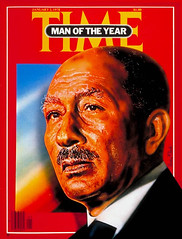A blog about teaching strategies, resources and ideas for Social Studies teachers to make learning fun, relevant and exciting!
Monday, October 31, 2011
Friday, October 28, 2011
Oct. 28, 1886 | Statue of Liberty Is Unveiled
Library of CongressThis engraving, based on a drawing by Charles Graham, shows New York Harbor and the Statue of Library illuminated by fireworks to celebrate the statue’s unveiling on Oct. 28, 1886.
Historic Headlines
Learn about key events in history and their connections to today.
On Oct. 28, 1886, President Grover Cleveland dedicated the Statue of Liberty, a gift from France, in New York Harbor. In that day’s edition, The New York Times described the building excitement for the ceremony: “All day yesterday people came to the city in droves to participate in to-day’s celebration. Extra heavily loaded trains, much behind schedule time, were the rule on every railroad entering the city. Every hotel was crowded to its utmost capacity last night, and there was hardly one of the better known hotels which did not have to turn away hundreds of would be guests.”
Read more…
Wednesday, October 26, 2011
Oct. 26, 1994 | Peace Between Israel and Jordan
Associated PressPresident Bill Clinton applauded as Prime Minister Yitzhak Rabin, left, of Israel and King Hussein of Jordan shook hands after signing a peace treaty on Oct. 26, 1994.
Historic Headlines
Learn about key events in history and their connections to today.
On Oct. 26, 1994, Prime Minister Yitzhak Rabin of Israel and Prime Minister Abdel Salam Majali of Jordan signed a peace treaty in a ceremony attended by President Bill Clinton.
After securing a peace treaty with the Palestinian Liberation Organization in September 1993, Israel next sought peace negotiations with Jordan. The two nations reached an agreement in July 1994 to end the “state of belligerency” between them that had existed since Israel’s founding in 1948. Each side pledged to seek peace after “generations of hostility, blood and tears and in the wake of years of pain and wars.”
Read more…
Monday, October 24, 2011
Friday, October 21, 2011
QWIKI Top News Ngayon : 10-21-2011
View Top News: 10-21-11 and over 3,000,000 other topics on Qwiki.
Wednesday, October 19, 2011
QWIKI Top News : 19 Oktubre 2011
View Top News: 10-19-11 and over 3,000,000 other topics on Qwiki.
Monday, October 17, 2011
Sino si Al Capone?
Kilala niyo ba si Al Capone? Alamin kung sino siya sa isang artikulo mula sa The Learning Network ng New York Times. Panoorin din ang isang trailer ng pelikulang 'The Untouchables', na ukol kay Al Capone.
United States Department of Justice This mug shot of Al Capone was taken four months before his tax eviction conviction on Oct. 17, 1931.
On Oct. 17, 1931, Chicago mobster Al Capone was convicted on five of 23 income tax evasion counts he faced, and which later yielded an 11-year prison sentence. During the trial, Mr. Capone’s efforts to avoid a strict sentence were thwarted by Judge James H. Wilkerson, who refused to offer a lenient sentence in exchange for a guilty plea. Wilkerson also swapped out the jury after Mr. Capone tried to bribe the people who were serving on it. The Oct. 18 New York Times reported that Capone was oddly calm as the verdict was read: “Capone grinned as though he felt he had gotten off easily. … Capone faces a maximum of seventeen years’ imprisonment and $50,000 fine. He did not seem to realize that. He kept grinning at all and sundry in the court room, his bulky figure in a screaming green suit (one of the $135 ones) drawing all eyes toward him.”
Capone was a legendary figure in the Chicago underworld. He became a mob boss in 1925 and generated millions of dollars from gambling and bootlegging rackets. He brutally eliminated his rivals—most famously in 1929, when his men killed seven members of George “Bugs” Moran’s gang in the St. Valentine’s Day Massacre. He held, according to the Times, “undisputed control of all the illegal sources of revenue in the city and its suburbs.”
Capone’s actions made him an obvious target for federal authorities. Having been convicted in 1929 of a weapons charge, he used his influence to secure a comfortable prison cell in which to serve his short sentence. He was not so lucky the second time around: he was closely guarded in several prisons, including Alcatraz. He was released in 1939, but by then his health had seriously declined as a result of having contracted syphilis. He was unable to return to mob life and died in 1947.
Sino si Al Capone?
United States Department of Justice This mug shot of Al Capone was taken four months before his tax eviction conviction on Oct. 17, 1931.
On Oct. 17, 1931, Chicago mobster Al Capone was convicted on five of 23 income tax evasion counts he faced, and which later yielded an 11-year prison sentence. During the trial, Mr. Capone’s efforts to avoid a strict sentence were thwarted by Judge James H. Wilkerson, who refused to offer a lenient sentence in exchange for a guilty plea. Wilkerson also swapped out the jury after Mr. Capone tried to bribe the people who were serving on it.
The Oct. 18 New York Times reported that Capone was oddly calm as the verdict was read: “Capone grinned as though he felt he had gotten off easily. … Capone faces a maximum of seventeen years’ imprisonment and $50,000 fine. He did not seem to realize that. He kept grinning at all and sundry in the court room, his bulky figure in a screaming green suit (one of the $135 ones) drawing all eyes toward him.”
Capone was a legendary figure in the Chicago underworld. He became a mob boss in 1925 and generated millions of dollars from gambling and bootlegging rackets. He brutally eliminated his rivals—most famously in 1929, when his men killed seven members of George “Bugs” Moran’s gang in the St. Valentine’s Day Massacre. He held, according to the Times, “undisputed control of all the illegal sources of revenue in the city and its suburbs.”
Capone’s actions made him an obvious target for federal authorities. Having been convicted in 1929 of a weapons charge, he used his influence to secure a comfortable prison cell in which to serve his short sentence. He was not so lucky the second time around: he was closely guarded in several prisons, including Alcatraz. He was released in 1939, but by then his health had seriously declined as a result of having contracted syphilis. He was unable to return to mob life and died in 1947.
Friday, October 14, 2011
YouTube Pilipinas, Meron Na!
Mahilig ka bang manood sa YouTube? May YouTube account ka ba? Nasa video sa ibaba na mula sa GMA News TV, ang ating top news sa linggong ito. At siyempre alam ko mahilig din kayong mag-YouTube pero ang tanong ko ay ito - Ngayong may YouTube Pilipinas na, ano sa palagay ninyo ang magiging epekto nito para sa mga mahilig manood sa YouTube? Isulat ang inyong komento sa ating Vialogue site na makikita sa link na ito!
Wednesday, October 12, 2011
Oktubre 12, 2011 - Historic Headlines
Kilala niyo ba si Hen. Robert Lee? Sinasabing sa araw na ito noong Oktubre 12, 1870, namatay si Hen. Robert Lee. Pero sino nga ba siya? Panoorin sa ibaba ang isang video mula sa PBS at magbigay ng inyong komento sa ating class blog ukol sa nalaman mo sa kaniya!
Julian Vannerson/Library of CongressThis portrait of Gen. Robert E. Lee was created in 1864, roughly one year before he surrendered his Confederate Army to Union troops, and approximately six years before his death on Oct. 12, 1870.Historic Headlines
Learn about key events in history and their connections to today.
On Oct. 12, 1870, Gen. Robert Edward Lee, best known for leading the Confederate Army of Northern Virginia in the Civil War, died. He was 63.
The Oct. 14 New York Times quoted the message that Gov. Gilbert Walker of Virginia sent to the General Assembly: “He died as he had lived, a noble example of the sublime principles and teachings of the Christian religion. He goes down to the tomb amid the lamentations of an affectionate and sorrowing people. Of exalted public and private virtue in his life and career, he filled up the full measure of our conception of a man.”
Read more…
Watch the full episode. See more American Experience.
Friday, October 7, 2011
Oktubre 7, 2011 - Historic Headlines
Basahin mula sa Learning Network ng New York Times ang ukol sa isang pangyayari na naganap 26 na taon na ang nakakaraan.
D. R. WalkerItalian cruise ship MS Achille Lauro, shown here around 1989, returned to service following the hijacking. On Dec. 2, 1994, it caught fire and sank off the coast of Somalia, killing two and injuring eight passengers.Historic Headlines
Learn about key events in history and their connections to today.
On Oct. 7, 1985, the Italian cruise ship MS Achille Lauro was hijacked by four members of the Palestine Liberation Front off the coast of Egypt in the Mediterranean. The hijackers took the more than 400 passengers and crew members hostage and demanded the release of 50 Palestinians from Israeli prisons.
The Oct. 8 New York Times reported: “The hijackers were quoted as saying they would blow up the ship if a rescue mission was undertaken. According to unconfirmed reports from Israeli radio monitors, the hijackers said they would begin killing the hostages unless their demands were broadcast on Egyptian radio and television.”
The following day, after the Syrian government refused to let them dock at the port of Tartus, the hijackers decided to execute one of the hostages: Leon Klinghoffer, a 69-year-old Jewish American, was tossed off the ship — in his wheelchair and in front of his wife, Marilyn Klinghoffer — after being killed.
The hijackers surrendered on the condition that they and the hijacking mastermind Abu Abbas be given a plane to escape. However, on Oct. 10, the plane was intercepted by United States military aircraft and forced to land at a NATO base in Sicily, where Mr. Abbas and the hijackers were arrested.
The American and Italian governments argued over jurisdiction to prosecute the hijackers. Italy would not extradite the men to the United States and, though it did convict the four hijackers, allowed Mr. Abbas to escape to Yugoslavia. He remained a free man until 2003, when he was captured by United States troops in Iraq; he died in custody the following year.
The Achille Lauro, meanwhile, went back into service as a cruise ship. In 1994, it caught fire while sailing off the coast of Somalia and sank. Two of the nearly 1,000 people on board died in the accident.
Connect to Today:
Today, there are many news stories of ship hijackings by pirates off the coast of Somalia, a country described by the Piracy at Sea Times Topics as one “of grinding poverty and internal chaos.”
What comparisons, if any, can you draw between the Somali pirates of today and the Palestinian gunmen who hijacked the Achille Lauro? How do their motives differ? How do the response and approach to negotiations differ? Given the increase in attacks in recent years, would you be willing to board a ship sailing near the East African Coast? Why or why not?
Learn more about what happened in history on Oct. 7»
Learn more about Historic Headlines and our collaboration with findingDulcinea »
Student Opinion | Ano ang iyong Personal Credo?
Basahin ang isang artikulo mula sa Learning Network ng New York Times at sagutin ang mga sumusunod na tanong.
1. Ano ang Personal Credo ni Steve Jobs ?
2. Ano naman ang iyong Personal na Credo?
3. Paano ka nagagabayan sa iyong buhay ng iyong Personal na Credo?
Steve Jobs is being eulogized the world over as a leader, innovator and risk-taker whose mantras included the Apple motto “Think different.” What are your own guiding principles?
Numerous Times articles review the legacy of Steve Jobs, including Steve Lohr’s piece “Reaping the Rewards of Risk-Taking,” in which he characterizes Mr. Jobs as a role model who turned seeming failure into opportunity and then success. He describes the often-quoted commencement address Mr. Jobs gave to the graduating class at Stanford in 2005:
“It turned out that getting fired from Apple was the best thing that could have ever happened to me,” he told the students. Mr. Jobs also spoke of perseverance. “Sometimes life hits you in the head with a brick,” he said. “Don’t lose faith.”
Mr. Jobs ended his commencement talk with a call to innovation, in one’s choice of work and in life. Be curious, experiment, take risks, he said. His admonition was punctuated by the words on the back of the final edition of “The Whole Earth Catalog,” which he quoted: “Stay hungry. Stay foolish.”
“And,” Mr. Jobs said, “I have always wished that for myself. And now, as you graduate to begin anew, I wish that for you.”
And David Pogue describes Mr. Jobs’s vision this way:
Here’s a guy who never finished college, never went to business school, never worked for anyone else a day in his adult life. So how did he become the visionary who changed every business he touched? Actually, he’s given us clues all along. Remember the “Think Different” ad campaign he introduced upon his return to Apple in 1997?
“Here’s to the crazy ones. The rebels. The troublemakers. The ones who see things differently. While some may see them as the crazy ones, we see genius.”
In other words, the story of Steve Jobs boils down to this: Don’t go with the flow.
Steve Jobs refused to go with the flow. If he saw something that could be made better, smarter or more beautiful, nothing else mattered. Not internal politics, not economic convention, not social graces.
Students: Tell us what you think about Steve Jobs’s legacy and what your own guiding principles are. What are your core beliefs? What would you say is your personal credo? How does that credo guide you in life?
News Quiz | Oktubre 7, 2011
Alamin ang balita mula sa New York Times sa link na ito. Pagtakatapos ay sagutan ang ating News Quiz para sa araw na ito! Enjoy!
Thursday, October 6, 2011
Oct. 6, 1981 | In Memoriam : Anwar Sadat
Kilala ninyo ba si Anwar Sadat? Ano ang nangyari sa kanya 30 taon na ang nakakaraan? Alamin ang ukol sa kaniya sa isang artikulo mula sa New York Times! Panoorin din sa ibaba ang isang video ukol kay Anwar Sadat mula sa ABCNews.
![]()
Via ABCNews
Wednesday, October 5, 2011
World Teachers Day
Ngayon ay Oktubre 5, 2011 at ngayong araw na ito ay World Teachers Day! Ano ang inyong ginawa sa araw na ito upang parangalan ang iyong natataging guro? Gusto mo bang maging isang guro? Gumawa ng isang panayam sa iyong paboritong guro at alamin ang ukol sa kanilang trabaho. Ibahagi ang inyong panayam sa buong klase.
Monday, October 3, 2011
3 Oktubre, Lunes - Balitang Qwiki
View Top News: 10-2-11 and over 3,000,000 other topics on Qwiki.










